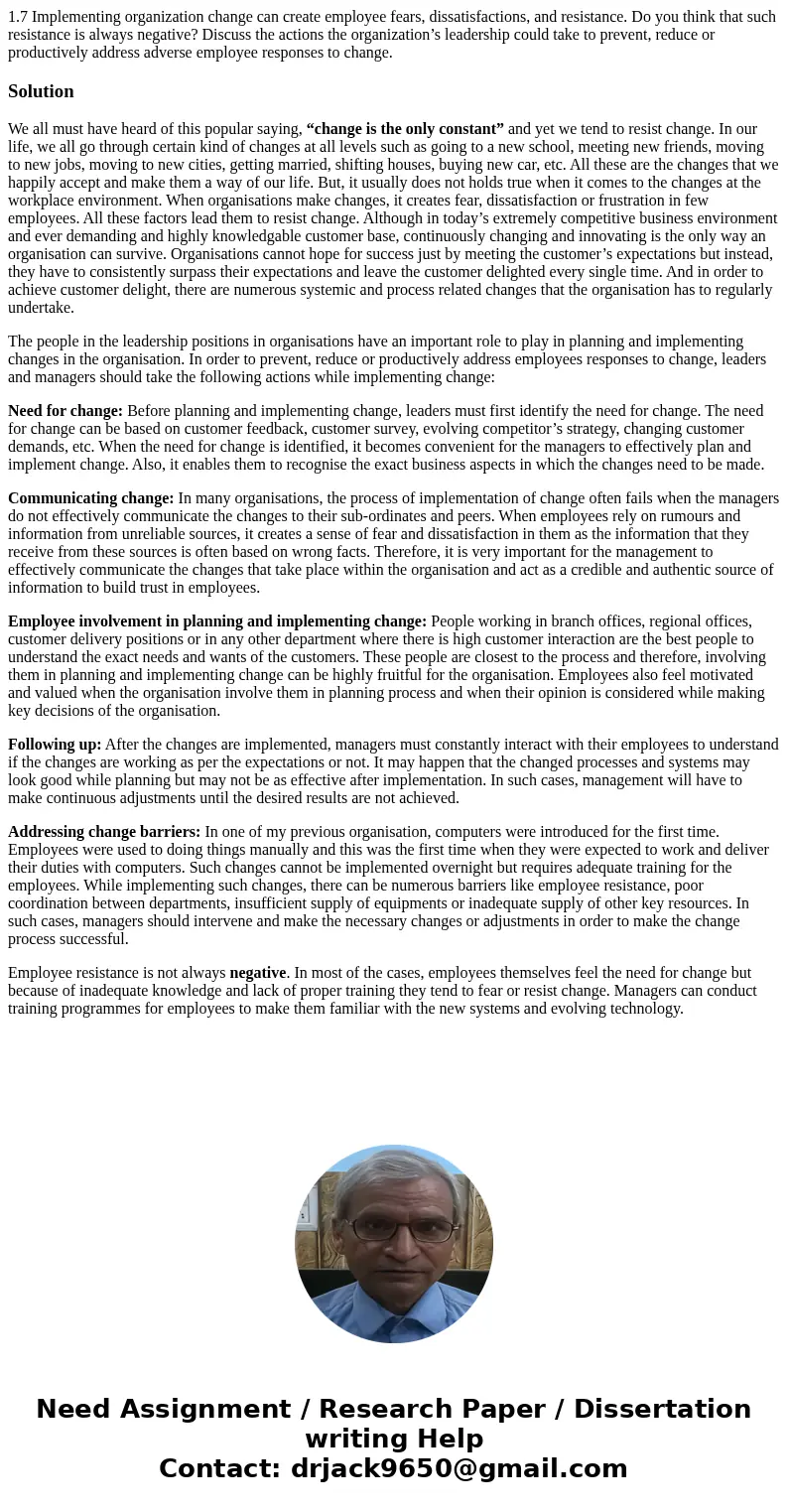17 Implementing organization change can create employee fear
1.7 Implementing organization change can create employee fears, dissatisfactions, and resistance. Do you think that such resistance is always negative? Discuss the actions the organization’s leadership could take to prevent, reduce or productively address adverse employee responses to change.
Solution
We all must have heard of this popular saying, “change is the only constant” and yet we tend to resist change. In our life, we all go through certain kind of changes at all levels such as going to a new school, meeting new friends, moving to new jobs, moving to new cities, getting married, shifting houses, buying new car, etc. All these are the changes that we happily accept and make them a way of our life. But, it usually does not holds true when it comes to the changes at the workplace environment. When organisations make changes, it creates fear, dissatisfaction or frustration in few employees. All these factors lead them to resist change. Although in today’s extremely competitive business environment and ever demanding and highly knowledgable customer base, continuously changing and innovating is the only way an organisation can survive. Organisations cannot hope for success just by meeting the customer’s expectations but instead, they have to consistently surpass their expectations and leave the customer delighted every single time. And in order to achieve customer delight, there are numerous systemic and process related changes that the organisation has to regularly undertake.
The people in the leadership positions in organisations have an important role to play in planning and implementing changes in the organisation. In order to prevent, reduce or productively address employees responses to change, leaders and managers should take the following actions while implementing change:
Need for change: Before planning and implementing change, leaders must first identify the need for change. The need for change can be based on customer feedback, customer survey, evolving competitor’s strategy, changing customer demands, etc. When the need for change is identified, it becomes convenient for the managers to effectively plan and implement change. Also, it enables them to recognise the exact business aspects in which the changes need to be made.
Communicating change: In many organisations, the process of implementation of change often fails when the managers do not effectively communicate the changes to their sub-ordinates and peers. When employees rely on rumours and information from unreliable sources, it creates a sense of fear and dissatisfaction in them as the information that they receive from these sources is often based on wrong facts. Therefore, it is very important for the management to effectively communicate the changes that take place within the organisation and act as a credible and authentic source of information to build trust in employees.
Employee involvement in planning and implementing change: People working in branch offices, regional offices, customer delivery positions or in any other department where there is high customer interaction are the best people to understand the exact needs and wants of the customers. These people are closest to the process and therefore, involving them in planning and implementing change can be highly fruitful for the organisation. Employees also feel motivated and valued when the organisation involve them in planning process and when their opinion is considered while making key decisions of the organisation.
Following up: After the changes are implemented, managers must constantly interact with their employees to understand if the changes are working as per the expectations or not. It may happen that the changed processes and systems may look good while planning but may not be as effective after implementation. In such cases, management will have to make continuous adjustments until the desired results are not achieved.
Addressing change barriers: In one of my previous organisation, computers were introduced for the first time. Employees were used to doing things manually and this was the first time when they were expected to work and deliver their duties with computers. Such changes cannot be implemented overnight but requires adequate training for the employees. While implementing such changes, there can be numerous barriers like employee resistance, poor coordination between departments, insufficient supply of equipments or inadequate supply of other key resources. In such cases, managers should intervene and make the necessary changes or adjustments in order to make the change process successful.
Employee resistance is not always negative. In most of the cases, employees themselves feel the need for change but because of inadequate knowledge and lack of proper training they tend to fear or resist change. Managers can conduct training programmes for employees to make them familiar with the new systems and evolving technology.

 Homework Sourse
Homework Sourse